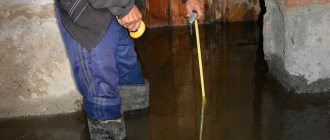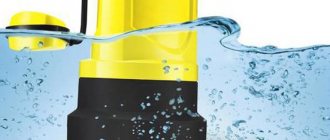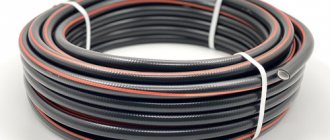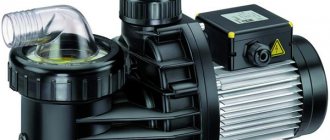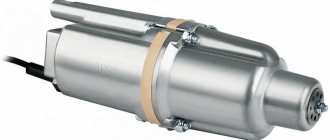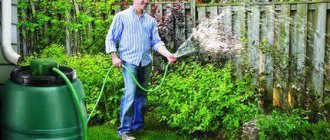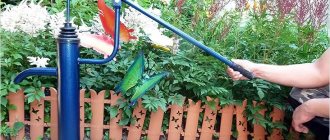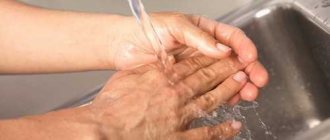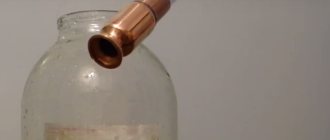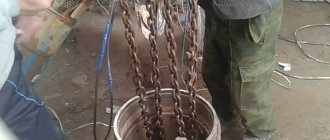Flooding of a home or a separate room becomes a real emergency, which unsettles and disrupts the usual rhythm of life. Most often, floods occur in kitchens and bathrooms, but it is not uncommon for residential areas to be flooded due to a burst radiator or flooding from upstairs neighbors. How to quickly and effectively dry a room and return it to habitable condition after a flood?
Types of pumps
Pumps for drinking water and dirty water
Pumps for industrial water
Divided into two types:
- fecal type;
- drainage type.
However, drainage pumps are capable of pumping liquids with large solid elements. Therefore, in order not to damage the unit, a filter with a fine mesh is attached to the pipe. This will prevent large waste from getting inside the unit. This type of pump is universal and can be used not only for basements and cellars. It is used when cleaning dirty swimming pools, artificially created reservoirs, and wells.
This is not the case with a fecal pump. It is not intended for pumping liquids containing solids. Some models of such devices may have a cutting mechanism for shredding large debris.
Submersible pump “Baby”
A representative of this type of pumping equipment is the “Malysh” submersible pump.
The pump is immersed in water, and it should not lie on the bottom, since it takes in liquid with the lower part, and at the bottom there are silty deposits that can clog it. The device does not require special cooling of the electric motor elements because the waste materials themselves have a low temperature. The device may be equipped with a circuit breaker. So, when the liquid reaches a specific point, using a float, the device is disconnected from the network. If the maximum level of wastewater is exceeded, the unit starts working again.
The Baby's body is equipped with reliable waterproofing. If the seal of the housing is broken, water can enter the engine and damage it. Therefore, you need to periodically remove the device from the water and check the integrity of the housing.
Submersible and external pumps
Principle of operation
These types, depending on the methods of work, are divided into submersible and external. The operation of a submersible pump involves its complete immersion in water.
These pumps must meet the following requirements:
- resistance to chemicals;
- to corrosive formations;
External pumps are only partially lowered into the liquid; the main part of the device is on the surface of the water. Basically, these devices are mobile, but less powerful than the submersible type, which helps save energy.
How to collect water from the floor when the room is flooded using a pump
Has your basement, room, or room been flooded and you urgently need to pump out the water? Use a German pump specially designed for this purpose, which in a matter of minutes will allow you to pump out water from a flat floor surface without the use of special drainage pits and additional tools for collecting water. All you need is a pump and a flexible hose to drain the water.
presents to your attention an updated line of HOMA drainage pumps developed by German engineers specifically to combat emergency flooding of residential and non-residential premises, as well as flat areas such as parking lots, training fields, swimming pool rooms, wash rooms and others, where the appearance of both rainwater and water is possible , which can get in during a flood, a violation of the waterproofing of buildings and a breakthrough in existing utility networks.
Features of external pumps
These devices are designed for periodic pumping of water.
Their prolonged use puts a lot of stress on the mechanism, which leads to breakdown. Liquid intake occurs through flexible hoses. In this way, it is possible to pump out liquids up to eleven meters deep. Moreover, the presence of large particles up to ten millimeters in water is acceptable.
Centrifugal type unit design
The unit has a pump chamber and a motor compartment. The rotor (shaft) connects the working compartment and the engine. The shaft contains wheels with blades designed to pump liquid and maintain high line pressure. This pump is easy to install. The body is mainly made of polymer or stainless steel.
Manufacturers of these pumps are such global brands as Gardena, Pedrollo, Karcher, Dab. There are also domestic manufacturers - Gileks and Sprut. The most popular brand of devices for pumping out dirty water is Pedrollo Pkm60. This model is capable of maintaining pressure up to forty meters, as well as pumping up to two thousand liters of water in 1 hour. Equipped with a cast iron body.
We should also highlight the OPTIMA JET 80S-PL pump, which has established itself as the best among the owners of country houses. The case is made of steel and has a power of up to eight hundred watts. Maintains pressure at a distance of up to thirty-three meters. Capable of pumping water up to 3 cubic meters. m/hour.
Centrifugal units
The housing of centrifugal pumps can be monolithic or cantilever.
The top of the device performs a protective function, and the work area is located at the bottom. The chamber contains impellers with an impeller in a circle. There is a filter with a mesh under the wheels. There is a stand on the bottom of the device. They have a throughput capacity of no more than two to two and a half centimeters. The following brands of submersible pumps are Aquatica, Grudfos, Gilex, Metabo, Sturm.
The most common is the Aosta AB SMP 400SS DO pump, which has a power of up to four hundred watts. The unit has an auxiliary discharge connection. Automated operation occurs through a float switch. Can work at a depth of up to five meters. Withstands water pressure at a distance of up to ten meters. Capable of pumping liquids up to 298 l/min.
You can also highlight the domestic pump Drainage 200/25, produced by the company Gilex.
Vibration units
The liquid is pumped through the oscillating movements of the resonator. Centrifugal devices are represented by dynamic devices, and vibrating devices are volumetric devices.
The working chamber of such devices has a membrane that serves as a closure to the engine compartment. It is fixed on a metal rod. The engine here is replaced by a capacitor, which attracts liquid during the working process.
At the same time, the working chamber expands, and water is drawn in through a vacuum. When the chamber narrows, the liquid is pushed into the pipe and the inlet is closed using an inverse valve. This ensures water supply without jerking. In terms of productivity, this type is inferior to the centrifugal one.
Water pumps of both submersible and surface types are quite expensive. So, for periodic use, it is not always advisable to purchase an expensive electric pump. The best option here would be to purchase a hand pump. This device is made like a pneumatic hand pump. Here the piston represents the working element.
When the handle is lifted upward, the rod and cylinder are tightened. In this case, the chamber is filled with rarefied air and water begins to be absorbed. When the handle is turned down, the pressure increases and the liquid closes the valve in the suction hole and all water under pressure is discharged through the pipe.
Naturally, in terms of functional characteristics, a manual type device cannot compete with electric devices, but in terms of ease of operation it can compete with electric models.
Recommendations for use
In order for the pump for pumping out dirty water to work without interruptions and frequent breakdowns, it is necessary to follow certain rules for its use. This also includes the conditions that must be created when operating the drainage pump.
- The ambient temperature in which the self-priming pump for dirty water operates should not exceed 40°.
- The density of the liquid for pumping out which self-priming drainage pumps are used should not exceed 1000–1200 kg/m3.
- The amount of solid inclusions in the liquid medium that the drainage pump will pump out should not exceed 10%.
- Industrial hydraulic machines for contaminated water are connected to a three-phase electrical network with a voltage of 380 V, household models - to a single-phase one (with a voltage of 220 V and a frequency of 50 Hz).
Drying the floor covering
Floor coverings suffer the most from flooding. In this regard, carpets and rugs must be taken out into the air to dry, wooden coverings: parquet or laminate must be disassembled to avoid deformation and swelling. It is advisable to remove the linoleum. The underlayment under the laminate will most likely have to be replaced. The freed concrete screed must be thoroughly dried.
How to choose the right model
Among the models of drainage pumps for dirty water, how to choose the best option? When purchasing a pump for pumping water from a basement or cellar, you should first decide on the list of tasks for which such equipment will be used. We list the parameters by which drainage, as well as well or borehole electric pumps are selected.
Characteristics of the pumped liquid
This refers to its type, degree of contamination, as well as the maximum particle size of solid inclusions contained in its composition. In particular, the diameters of the inlet and pressure pipes of the selected pump, as well as the volume of its internal working chamber, depend on this characteristic.
The stainless steel mesh filter is reliable and durable
Performance
This parameter characterizes the volume of liquid that the pump is capable of pumping per unit of time. You should focus on the degree of intensity with which you plan to use the pumping equipment, as well as the amount of dirty water that it will have to pump out.
Created pressure
This parameter determines the degree of contamination of the liquid that a pump of a certain model can pump out from a cellar or basement, and the distance over which the pumped liquid will be transported along a horizontal section of the pipeline or hose. The depth from which such equipment can pump out a liquid medium also depends on the pressure value created by the electric pump. If you are thinking about how to pump water from a well or borehole and ensure its transportation through an irrigation or water supply system, consider not only the depth of the underground source and the total length of the horizontal section of the pipeline, but also the height to which the water pumped must be raised above the surface of the earth.
Ease of use will also be an important criterion for choosing a pump. For example, easy adjustment of the pumping level by moving the sensor or quick connection of the pressure hose
Location of the inlet pipe
The inlet pipe can be located at the top or bottom of the pump housing, as well as on its side. In the event that the selected hydraulic machine is planned to be used for pumping liquid media from flooded cellars or basements, preference should be given to models with a lower nozzle location. If, with the help of a drainage pump, water will be pumped out of silted reservoirs, it is better to choose equipment with an upper location of this element.
Availability of additional options
If you are interested in purchasing a really good drainage pump, it is better to opt for models that are equipped with all the necessary automation elements. This includes, in particular, idle and overheat sensors, as well as float-type switches. In this case, you need to know the following fact: while floatless drainage pumps can be selected for pumping water from basements, trenches or cellars, it is not recommended to use them for pumping liquid media from wells, septic tanks or cesspools.
If you do not take into account the prestige of the manufacturer, the cost of drainage pumps is significantly influenced by their performance and the ability to pump liquids with large solid particles
Technical creativity at USFTU
Some time ago it turned out that the waterproofing of the basement at the dacha leaves much to be desired, and after rain there are regularly puddles on the floor. After “dipping” a couple of buckets of water with a mop several times, I decided “enough to endure this!” and went online to find a solution. I wanted to choose something quite simple and inexpensive. Surface pumps are sometimes not too expensive, but they require manual work - connecting hoses to collect water from the floor and draining the pumped water into a bucket, besides - no one could guarantee that they will help with collecting a very thin, 1-3 mm, layer water from the floor.
After some deliberation, the option with a homemade “cyclone” filter connected to the vacuum cleaner was chosen. The “cyclone” filter is more often used to clean dusty air - its operating principle is based on the creation of a swirling air flow directed from top to bottom of a cylindrical body, most often having a conical part at the bottom. In this case, solid particles are pressed against the walls by centrifugal force and then settle into a special hopper, or, in its absence, into the lower part of the container itself (see figure). You can read more, for example, here.
Cyclone filter, operating principle
The same principle is successfully applied to collecting water - centrifugal force, like dust, separates liquid from air.
Many “advanced” designs from the Web were immediately discarded as too complex. I wanted to make do with a minimum of manufacturing time, and besides, the unit had to be powered by an old household vacuum cleaner - the farm doesn’t have an industrial one. In the end, the choice settled on a plastic bucket left over from a recent renovation. In the construction hypermarket, gray plastic sewer pipes, beloved by many “homemade” ones, were purchased - they are quite durable, not subject to corrosion, relatively inexpensive, have couplings with a rubber ring, are easy to cut (for example, with a hacksaw), and, moreover, for them There are many different connecting fittings available.
Many people drill holes in plastic lids with specially purchased crowns. In my opinion, a much more versatile device for drilling round holes in tiles and other sheet materials, called a “ballerina” for its characteristic shape. Using a similar device, which, unlike those shown, has only one cutter, two holes were drilled in the lid.
Compact pumping stations for domestic use
For the uninterrupted and efficient functioning of autonomous water supply systems for dachas and private houses in automatic mode, compact pumping stations have recently been increasingly used. The use of such stations, which include several technical devices, makes it possible to minimize human participation in controlling the operation of pumping equipment due to automation elements. The compact dimensions of household pumping stations for pumping water, which, despite their small size, are characterized by high performance and are capable of creating good pressure in the pipeline system, allow such equipment to be installed in any convenient place, including in the basement of a residential building.
The household pumping station includes the following technical devices:
- submersible centrifugal pump that pumps water from an underground source;
- a filtration unit in which water from an underground source is purified from solid inclusions;
- a circulation pump designed to pump water from the filter unit to the station’s hydraulic accumulator;
- a hydraulic accumulator, the internal chamber of which, filled with water, is equipped with a special membrane (the task of this device is to maintain constant pressure of the liquid medium in the autonomous water supply system, as well as to provide this system with water in those moments when the station pump does not work due to a breakdown or lack of power).
Automatic pumping station for individual water supply systems and small garden plots
The operation of a household pumping station in automatic mode is ensured by a pressure switch, which automatically turns off the pumping equipment if the level of water pressure in the accumulator rises to a critical level, and also turns it on when such pressure drops below the permissible value.
Mini-pumps are actively used not only in everyday life, but also in industry, in particular in food industry enterprises. To pump liquid and viscous media used in technological processes at enterprises in this industry, special food pumps are needed, the structural elements of which are made of materials that are highly resistant to oxidation and do not release harmful substances into the pumped medium.
What happens if, after a house is flooded, it is not drained in time?
Flooding of the house and a large amount of moisture in the premises does not bode well. Failure to properly dry your walls, roof, and floors will all lead to mold, mildew, and an unpleasant, musty odor in your home.
But that's not all that bad. Mold and mildew spores tend to spread through the air, which means your family's health will be at risk. Therefore, you should get rid of excess water and moisture in the house as soon as possible, as well as the consequences of flooding (rot and stains on the walls). We recommend ordering professional home drying after a flood here: https://sushka.pro/.
Is it possible to dry a house on your own? Yes it is possible. Just consider two important factors: the availability of the necessary equipment and time. Please note that you cannot delay in this matter; just a few hours after the house is flooded is enough for all elements of the building’s structure: ceiling, walls, floor and roof to absorb a huge amount of water, which will lead to the above-mentioned consequences.
In this article we will tell you how to dry houses and how to effectively get rid of the consequences of flooding at home, and also give ways to quickly dry the surfaces of walls, floors and ceilings.
Overview of possible options
A pool in the basement, garden or home should ensure the safety of swimmers. Therefore, the presence of blooming water in the bowl that does not meet the requirements of sanitary and hygienic standards should under no circumstances be allowed. To prevent problems and timely cleaning of the walls of the bowl, water is periodically pumped out of the pool using various pumps.
1. Immersion format – a combination of simple design and impressive functionality
Using submersible pumping equipment for his pool, the developer will be able to pump water through a grate located in his body. Using the equipment is very simple - it is placed on the bottom of the pool and the motor is started, after which the water is pumped and supplied upward. The device is used not only for pools, but also for draining wells, cesspools, basements and cellars.
Among the advantages of the pump, it is worth highlighting its prevalence, light weight, compact dimensions and affordability. The disadvantages also cannot be ignored. They are represented by limited performance.
2. Surface pump – ease of use and high power
If for some reason the developer does not consider the possibility of using submersible equipment, he still has the option of using a surface pump. It has a completely different format. The equipment is placed above the surface of the water surface, and a special flank connected to the body is lowered into a bowl of water. When the equipment motor is started, water begins to be pumped out of the tank.
Cleaning up after a minor flood
If the damage is not serious, the electrician has confirmed that there is no risk of a short circuit, and you are sure that the water damaged only a small area, you can try to avoid repairs.
A small spot on the ceiling or wall should simply be cleaned and painted over with two layers of paint. If stains still appear, you need to clean the area with a spatula and sandpaper. Then let it dry, spray with an antifungal compound and apply a deep-penetrating primer. Finishing putty is already applied to it and, after drying, primer and paint.
Review of models and manufacturers
The selection of equipment begins with an inspection of how much a particular model costs.
But it is important to pay attention to the manufacturer. Here are several options for water pumping/pumping equipment that are deservedly popular:
- A water jet is equipment designed for pumping flows from a well/borehole. The throughput of insoluble inclusions is low, price starts from $80
- Baby - a design ideal for summer cottages. Low performance affects the low price (from $40).
- A brook is a device for supplying water from wells and wells of medium depth. Unpretentiousness to the percentage of contamination, excellent performance, ease of installation and lightness of the device are complemented by low cost (from $30), but the service life is no more than 3-5 years.
- The Gilex model range is equipment intended for domestic use in both water supply and sewerage systems. Excellent practical qualities, work with different depths, unpretentiousness to contamination, a very long service life and good maintainability are clear advantages of the brand. Equipment cost from $200
- Belamos - models are used for supplying clean drinking water and irrigation. They have a built-in control unit, which makes the units easier to use, and can operate in manual, automatic and scheduled modes. There is also a filter to improve the quality of the supplied flow, overload protection, productivity up to 2800 l/hour, supply depth up to 8 meters. Price from 150 $
- Gardena is a brand of highly reliable equipment. Universal devices are able to cope with the supply of liquid without interruptions to high floors, be used for irrigation and at the same time are unpretentious to contamination, as they are equipped with a high-quality filter. Power up to 4000 l/hour, readiness for use immediately after purchase, the presence of 2 outlets for a hose (for irrigation and supply of drinking water), a low noise threshold and a drainage tube for draining liquid add advantages to the device. Price from 120 $
- Aquarius is an ideal pump for wells up to 45 meters deep. The reliability of the unit is confirmed by the execution of parts made of brass and stainless steel, there is a thermal relay, as well as complete immunity to power supply fluctuations (performance will decrease, but the device will not break). Silent operation is also a plus, but it is better to use the unit on clean flows. Price from 120 $
- Vortex – pumps for deep wells (from 60 meters). Chrome parts, a durable body, a pressure of up to 100 meters and a price from $100 are the advantages of the unit. But energy consumption up to 1100 W is a drawback. However, the presence of overheating protection functions, smooth running, high pressure, and high-quality assembly exceed the disadvantages.
All presented models from the Russian manufacturer have unique features - they are adapted to power outages, are resistant to mechanical stress and are easy to install. For users who prefer more expensive units, there are alternative options:
- The Grundfos model range is an offer from German manufacturers. The company produces equipment for supplying and pumping liquids from wells, boreholes, and reservoirs. The devices are equipped with sensors for overheating, overload, protection against dry running and voltage surges. Such functionality significantly extends the life of the devices, but raises the price to $150. However, no matter how much the units cost, they deserve their price - the brand, according to consumers, is considered a leader in its field.
- Unipump is a brand of equipment indicated for use in wells with a high content of insoluble inclusions (up to 100 g/m3). Supply height up to 52 meters, productivity up to 4.8 m3/hour. There is overheating protection, soft start, and automatic operation, but you will have to be careful when using it if the liquid is very hard. Price starts from $110, efficiency and noiselessness are advantages, but a weak network drive is a disadvantage of the equipment.
A preliminary analysis of the needs, the design of the water intake source, determination of the length of the flow supply and the functional features of the water supply will allow not only to choose a good quality device, but also to correctly determine exactly how many pumps will be required for the uninterrupted supply of water to a house, farm or suburban area.
Repair after flooding
Once you have taken care of stopping the flow of water and have collected all the documents that will help compensate for the damage, you can begin cleaning and restoration. At the beginning of the renovation, you need to assess how dangerous it is for residents and furniture to be in the room. If the flooding is serious and it is impossible to connect electricity, you will have to temporarily move out and remove furniture, especially wooden ones. It may also be necessary to remove wooden doors and lay parquet flooring.
Wiring check
Even if the flood did not cause a short circuit, wait 7-10 days to allow all materials to dry and call an electrician to check the entire electrical system of the house. Only after inspection by a specialist and confirmation that nothing needs to be changed can the electricity be connected.
Dismantling damaged surfaces
If the room has a suspended vinyl ceiling, you are in luck - it will collect all the water, sagging, and protect the room. All that remains is to call a professional to very carefully drain the water and dry the ceiling using a heat gun. If there was little water and everything was done carefully, there will be no need for repairs.
All other types of ceilings, as well as wall and floor coverings, as a rule, have to be completely renewed, since stains remain on the wallpaper and paint, and the laminate swells when water gets under it. Therefore, dismantling is carried out first.
Drying the room
After you have gotten rid of the damaged surfaces, install a heater or heat gun in the room. It is necessary to dry the ceiling, walls and floors, otherwise the moisture accumulated in them will lead to the formation of stains and mold.
At the same time, brickwork and concrete easily absorb water, but are not seriously damaged. And wooden or porous partitions may need to be replaced.
Antifungal treatment
After the room has dried, treat all areas that received water with antifungal fungicidal agents. If the flooding has been severe and you smell dampness in the room, use a strong substance such as Olympus Stop Mold. It is sold in liquid form and is applied using a synthetic brush or roller.
If you are sure that the surfaces are well dried and the air in the apartment is not damp, you can use sprays, for example, Neomid Bio.
